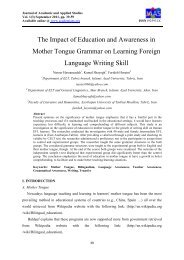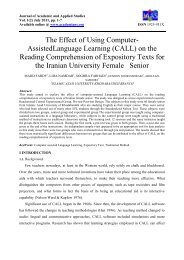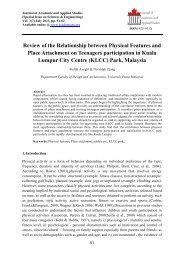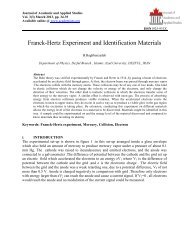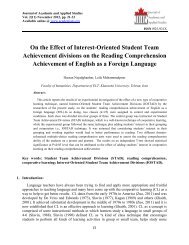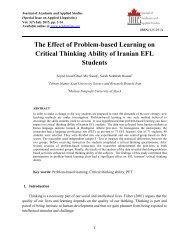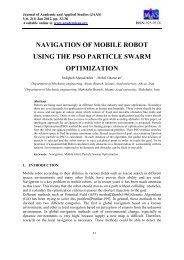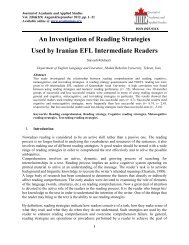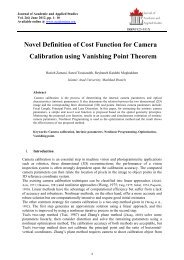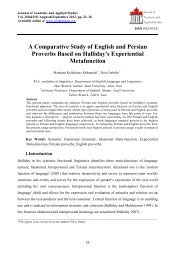The Role of Teachers in Learners' Motivation - Journal of Academic ...
The Role of Teachers in Learners' Motivation - Journal of Academic ...
The Role of Teachers in Learners' Motivation - Journal of Academic ...
Create successful ePaper yourself
Turn your PDF publications into a flip-book with our unique Google optimized e-Paper software.
<strong>Journal</strong> <strong>of</strong> <strong>Academic</strong> and Applied Studies<br />
Vol. 3(4) February 2013, pp. 45-54<br />
Available onl<strong>in</strong>e @ www.academians.org<br />
ISSN1925-931X<br />
Second Language <strong>Motivation</strong>; <strong>The</strong> <strong>Role</strong> <strong>of</strong> <strong>Teachers</strong> <strong>in</strong><br />
Learners’ <strong>Motivation</strong><br />
Mastoor Al Kaboody<br />
Northern Arizona University<br />
Abstract<br />
<strong>The</strong> purpose <strong>of</strong> this paper is to explore the ma<strong>in</strong> body <strong>of</strong> literature on motivation <strong>in</strong> second language<br />
learn<strong>in</strong>g. It aims to discuss the major theories <strong>of</strong> motivation on the <strong>in</strong>fluence <strong>of</strong> teachers on learners’<br />
motivation and to expla<strong>in</strong> how teachers can generate and ma<strong>in</strong>ta<strong>in</strong> motivation <strong>in</strong> their teach<strong>in</strong>g practices.<br />
Based on the vast body <strong>of</strong> research on motivation, this paper suggests that teachers have a huge<br />
responsibility to <strong>in</strong>itiate learners’ motivation and keep it alive throughout the learn<strong>in</strong>g process. Moreover, it<br />
synthesizes the conclusions drawn from the literature on motivation conducted to identify strategies and<br />
pr<strong>in</strong>ciples appropriate to be used by teachers <strong>in</strong> their classrooms.<br />
Introduction<br />
<strong>Motivation</strong> plays a significant role <strong>in</strong> the rate and success <strong>of</strong> second and foreign language<br />
learn<strong>in</strong>g <strong>in</strong> general, and <strong>in</strong> classroom language learn<strong>in</strong>g <strong>in</strong> particular. <strong>Motivation</strong> “provides the<br />
primary impetus to <strong>in</strong>itiate learn<strong>in</strong>g the second language and later the driv<strong>in</strong>g force to susta<strong>in</strong> the<br />
long and <strong>of</strong>ten tedious learn<strong>in</strong>g process” (Dörnyei, 1998, p. 117). <strong>Motivation</strong>, however, is “a<br />
complex” and “multifaceted construct” (Gardner, 1985; Williams & Burdoen, 1997). It consists<br />
<strong>of</strong> such factors as the attached value <strong>of</strong> a task, the rate <strong>of</strong> success expected by learners, whether<br />
learners believe they are competent enough to succeed, and what they th<strong>in</strong>k to be the reason for<br />
their success or failure at the task (Dörnyei & Ushioda, 2011).<br />
Motivat<strong>in</strong>g learners to develop <strong>in</strong> the target language is acknowledged to be a complex<br />
process. In many <strong>in</strong>stances, students face many obstacles <strong>in</strong> learn<strong>in</strong>g English and are <strong>of</strong>ten<br />
demotivated to learn. However, certa<strong>in</strong> motivational strategies, identified by research on<br />
motivation, can help learners adopt more positive attitudes towards language learn<strong>in</strong>g. This<br />
papersynthesizes major theories on motivation, discusses the role <strong>of</strong> teachers <strong>in</strong> motivat<strong>in</strong>g<br />
students, and presents a comprehensive review <strong>of</strong> motivational strategies that can be used by<br />
teachers <strong>in</strong> their classrooms. This paper concludes with a call for teachers to focus more on<br />
learners’ motivation and try to employ appropriate motivational strategies so thatthey can<br />
achieve their ultimate purpose <strong>of</strong> help<strong>in</strong>g students make the most <strong>of</strong> their language learn<strong>in</strong>g<br />
experience.<br />
45
<strong>Journal</strong> <strong>of</strong> <strong>Academic</strong> and Applied Studies<br />
Vol. 3(4) February 2013, pp. 45-54<br />
Available onl<strong>in</strong>e @ www.academians.org<br />
ISSN1925-931X<br />
Overview <strong>of</strong> <strong>The</strong>ories on <strong>Motivation</strong><br />
Research <strong>in</strong>to second language motivation dates back to the late 1950s and flourished <strong>in</strong> the<br />
1970s with the pioneer<strong>in</strong>g work <strong>of</strong> Lambert and Gardner. Gardner (1985) proposed three key<br />
components <strong>of</strong> L2 motivation: (a) “motivational <strong>in</strong>tensity or effort,” (b) “desire to learn the<br />
language,” and(c) “attitudes towards learn<strong>in</strong>g the language”, (Dörnyei& Ushioda, 2011, p. 41).<br />
Gardner dist<strong>in</strong>guishes between motivation and what he called orientation, where orientation<br />
stands for a goal. Orientation is an <strong>in</strong>centive that gives rise to motivation and steers it towards a<br />
set <strong>of</strong> goals. Strictly speak<strong>in</strong>g, orientations are not part <strong>of</strong> motivation but function as<br />
“motivational antecedents” (Dörnyei & Ushioda, 2011, p. 41). Gardner identified two ma<strong>in</strong><br />
orientations through his research: an <strong>in</strong>tegrative orientation, which is an <strong>in</strong>terest <strong>in</strong> <strong>in</strong>teract<strong>in</strong>g<br />
with the L2 language group; and an <strong>in</strong>strumental orientation, an <strong>in</strong>terest <strong>in</strong> the more materialistic<br />
and practical advantages <strong>of</strong> learn<strong>in</strong>g a new language, such as aspiration for a better career. <strong>The</strong><br />
<strong>in</strong>tegrative component <strong>in</strong> Gardner’s work is consistently cited <strong>in</strong> empirical studies as “expla<strong>in</strong><strong>in</strong>g<br />
a significant portion <strong>in</strong> the variance <strong>in</strong> language learners’ motivational disposition and motivated<br />
learn<strong>in</strong>g behavior” (Dörnyei, 2003, p. 5). Gardner described the difference between these<br />
orientations and actual motivation. For example, an <strong>in</strong>tegrative orientation was a class <strong>of</strong> reasons<br />
suggest<strong>in</strong>g why a person might undertake language study, <strong>in</strong>clud<strong>in</strong>g a desire to <strong>in</strong>tegrate with a<br />
particular language community. By itself, this reflected a goal that might or might not lack<br />
motivational power. In contrast, an <strong>in</strong>tegrative motive <strong>in</strong>cluded this orientation, plus the<br />
motivation, which <strong>in</strong>cluded desire, motivational <strong>in</strong>tensity, and a number <strong>of</strong> other attitudes<br />
<strong>in</strong>volv<strong>in</strong>g the target language community.<br />
However, Gardner’s socio-educational model was criticized on the basis <strong>of</strong> its emphasis<br />
on the <strong>in</strong>tegrative orientation. Clement and Kruidenier (1983) conducted a research study <strong>in</strong><br />
order to identify additional factors that <strong>in</strong>fluence motivation. <strong>The</strong> f<strong>in</strong>d<strong>in</strong>gs showed four different<br />
orientations to language study. <strong>The</strong> <strong>in</strong>strumental orientation was an important factor, associated<br />
with reasons such as travell<strong>in</strong>g, seek<strong>in</strong>g new friendships, and acquir<strong>in</strong>g knowledge. <strong>The</strong>y<br />
asserted that “relative status <strong>of</strong> learner and target groups as well as the availability <strong>of</strong> (or at least<br />
familiarity with) the latter <strong>in</strong> the immediate environment are important determ<strong>in</strong>ants <strong>of</strong> the<br />
emergence <strong>of</strong> orientations” (p. 288).<br />
<strong>The</strong> 1990s saw a shift from the socio-educational model <strong>of</strong> motivation to an emphasis on<br />
a psychological model, which views motivation as a more dynamic factor, more cognitive <strong>in</strong><br />
nature, and more established <strong>in</strong> the educational contexts where most L2 learn<strong>in</strong>g occurs. This<br />
shift came with Dörnyei’s concern to expand the model <strong>of</strong> motivation beyond two orientations.<br />
He stated that “the exact nature <strong>of</strong> the social and pragmatic dimensions <strong>of</strong> second language<br />
motivation is always dependent on what languages where” (Dörnyei, 1994, p. 275). His<br />
motivational model was categorized <strong>in</strong>to language level, learner level, and learn<strong>in</strong>g situation<br />
level. <strong>The</strong> language level refers to aspects <strong>of</strong> the L2, <strong>in</strong>clud<strong>in</strong>g the culture, community, and the<br />
values and benefits associated with it. <strong>The</strong> <strong>in</strong>dividual level consists <strong>of</strong> the learner characteristics<br />
that language learners br<strong>in</strong>g to the classroom. However, the learn<strong>in</strong>g situation <strong>in</strong>volves various<br />
factors <strong>in</strong>clud<strong>in</strong>g the classroom environment, teacher, learn<strong>in</strong>g context, teach<strong>in</strong>g methods,<br />
classmates, and teacher personality. <strong>The</strong> <strong>in</strong>trigu<strong>in</strong>g factor <strong>in</strong> Dörnyei’s model is that each <strong>of</strong> the<br />
three levels <strong>of</strong> motivation operates <strong>in</strong>dependently <strong>of</strong> the others.<br />
46
<strong>Journal</strong> <strong>of</strong> <strong>Academic</strong> and Applied Studies<br />
Vol. 3(4) February 2013, pp. 45-54<br />
Available onl<strong>in</strong>e @ www.academians.org<br />
ISSN1925-931X<br />
Unlike Gardner’s focus on <strong>in</strong>tegrativeness, Dörnyei argued that <strong>in</strong> an EFL context,<br />
<strong>in</strong>strumental orientation would have a greater impact on language learners. In addition, research<br />
on L2 motivation by Dörnyei (1990, 1994, 1997, 2001a, 2001b),Dörnyei and Ushioda (2011),<br />
and Williams (1994) revealed a need for a more pragmatic education centered approach,<br />
<strong>in</strong>vestigat<strong>in</strong>g classroom reality and identify<strong>in</strong>g and exam<strong>in</strong><strong>in</strong>g classroom specific motives.<br />
Cortazzi and J<strong>in</strong> (1999), on the other hand, found that culture and identity are two essential<br />
variables <strong>in</strong> motivat<strong>in</strong>g L2 learners. Dörnyei and Ushioda (2011) <strong>in</strong>troduced a new approach <strong>in</strong><br />
L2 learn<strong>in</strong>g labeled “L2 motivational self-esteem,” which l<strong>in</strong>ks the learn<strong>in</strong>g <strong>of</strong> a foreign<br />
language to one’s personal identity. This approach has implications for learn<strong>in</strong>g a foreign<br />
language <strong>in</strong> that the learner develops self-maturity and thus self-motivation <strong>in</strong> acquir<strong>in</strong>g the<br />
target language.<br />
Another theory, which captures both the dynamic dimension <strong>of</strong> motivation and its<br />
relevance for classroom applications, is the self-determ<strong>in</strong>ation theory. <strong>The</strong> theory was <strong>in</strong>itially<br />
developed by Deci and Ryan (between1985-1995);it is concerned with support<strong>in</strong>g learners’<br />
natural or <strong>in</strong>tr<strong>in</strong>sic tendencies to behave <strong>in</strong> effective ways. <strong>The</strong> self-determ<strong>in</strong>ation theory<br />
conta<strong>in</strong>s three orientations to motivation, which are placed on a cont<strong>in</strong>uum <strong>of</strong> <strong>in</strong>creas<strong>in</strong>g selfdeterm<strong>in</strong>ation:<br />
amotivation, extr<strong>in</strong>sic motivation, and <strong>in</strong>tr<strong>in</strong>sic motivation. First, amotivation<br />
occurs when learners see no relation between their actions and the consequences <strong>of</strong> their actions.<br />
Amotivated language learners believe that they are wast<strong>in</strong>g their time study<strong>in</strong>g the L2. <strong>The</strong>y do<br />
not value language learn<strong>in</strong>g and do not expect to be successful (Ryan & Deci, 2000).<br />
Amotivation should not be confused with demotivation, which refers to a reduction <strong>of</strong> motivation<br />
due to some specific external forces (Dörnyei, 2001).Dörnyei (2001) made a dist<strong>in</strong>ction between<br />
amotivation and demotivation. Demotivation concerns “specific forces that reduce or dim<strong>in</strong>ish<br />
the motivational basis <strong>of</strong> a behavioral <strong>in</strong>tention or an ongo<strong>in</strong>g action” (Dörnyei, 2001, p.<br />
143).Demotivation refers to a decrease <strong>of</strong> motivation. Demotivated learners were once<br />
motivated, but due to some external causes, they became demotivated. Demotivation might be<br />
brought by an attractive alternative or distraction. For example, a student decides to watch TV<br />
<strong>in</strong>stead <strong>of</strong> do<strong>in</strong>g homework. On the other hand, Dörnyei (2001) claims that when the outcomes<br />
are believed to be unrealistic and unreasonable, this results <strong>in</strong> amotivation. Amotivation, thus, is<br />
brought about by a belief that there is no po<strong>in</strong>t <strong>in</strong> do<strong>in</strong>g someth<strong>in</strong>g. That is to say, the learner<br />
realizes that that goal is not achievable and it is beyond his or her ability. Basically, amotivation<br />
is a lack <strong>in</strong> motivation.<br />
Extr<strong>in</strong>sic motivation refers to the pressure or reward from the social environment to learn<br />
a language. Extr<strong>in</strong>sically motivated learners aim to obta<strong>in</strong> a better career opportunity, a teacher’s<br />
praise or recognition or even to prove that one is a good learner. However, a characteristic <strong>of</strong><br />
external motivation is that it implies some k<strong>in</strong>d <strong>of</strong> external pressure which, once removed, may<br />
result <strong>in</strong> the language learner quitt<strong>in</strong>g the L2 learn<strong>in</strong>g (Noels, Clement, & Pelletier, 2001).<br />
Intr<strong>in</strong>sic motivation, on the other hand, is more self-determ<strong>in</strong>ed and refers to <strong>in</strong>ternal<br />
factors such as enjoyment and satisfaction for oneself. Intr<strong>in</strong>sically motivated learners perform<br />
an activity for the feel<strong>in</strong>gs associated with explor<strong>in</strong>g new ideas and develop<strong>in</strong>g knowledge, the<br />
sensations related to attempt<strong>in</strong>g to master the task or achieve a goal. Accord<strong>in</strong>g to Ryan and Deci<br />
(2000), the feel<strong>in</strong>gs <strong>of</strong> satisfaction <strong>in</strong> <strong>in</strong>tr<strong>in</strong>sic motivation come from a sense <strong>of</strong> competence,<br />
autonomy, and relatedness.<br />
47
<strong>Journal</strong> <strong>of</strong> <strong>Academic</strong> and Applied Studies<br />
Vol. 3(4) February 2013, pp. 45-54<br />
Available onl<strong>in</strong>e @ www.academians.org<br />
ISSN1925-931X<br />
<strong>The</strong> Influence <strong>of</strong> the Teacher on Learners’ <strong>Motivation</strong><br />
Research <strong>in</strong>to motivation <strong>in</strong> second language acquisition (SLA) <strong>in</strong> recent years has focused on<br />
the factors which affect second language (L2) learners’ motivation (e.g., Csizer &Dörnyei, 2005;<br />
Dörnyei& Clement, 2001; Dörnyei& Otto, 1998; Oxford & Shear<strong>in</strong>, 1994). <strong>The</strong> researchers<br />
concluded that teachers are one <strong>of</strong> the most determ<strong>in</strong>ant factors <strong>of</strong> L2 learners’ motivation<br />
(Dörnyei, 1994; Tanaka, 2005). Other studies set out to <strong>in</strong>vestigate how teachers positively affect<br />
learners’ motivation (e.g., Kikuchi, 2009; Sakai & Kikuchi, 2009; Tanak, 2005). <strong>The</strong>se studies<br />
proposed that L2 teachers play one <strong>of</strong> the most <strong>in</strong>fluential roles to help students engage and<br />
persist <strong>in</strong> the long process <strong>of</strong> second language acquisition. Among the role that teachers play <strong>in</strong><br />
L2 classes are <strong>in</strong>itiator, facilitator, motivator, ideal model <strong>of</strong> the target language speaker, mentor,<br />
consultant, and mental supporter. <strong>The</strong>se roles are assumed to <strong>in</strong>fluence each learner’s motivation.<br />
Ramage (1990) suggested that teachers should attempt to enhance learner motivation so that<br />
learners positively and actively engage <strong>in</strong> their learn<strong>in</strong>g until they reach their common target <strong>in</strong><br />
L2 learn<strong>in</strong>g. However, the impact <strong>of</strong> teach<strong>in</strong>g strategies on motivat<strong>in</strong>g students should rely on<br />
students perceptions <strong>of</strong> the strategies, as Dörnyei (2001) has proposed.<br />
Many empirical studies <strong>of</strong> teacher’s motivation were conducted to identify how teachers<br />
<strong>in</strong>fluence learners’ motivation. Dörnyei and Csizer (1998) have studied the use <strong>of</strong> teach<strong>in</strong>g<br />
strategies to motivate learners among Hungarian teachers <strong>of</strong> English. <strong>The</strong> researchers assigned<br />
51 motivational strategies and studied the significance attributed to each strategy by the teachers<br />
and how <strong>of</strong>ten teachers employ each strategy <strong>in</strong> their classes. This study leads to ten<br />
commandments for teachers to motivate language learners: teachers should set a personal<br />
behavior example, make sure that the class atmosphere is relaxed and pleasant, present task<br />
properly to the learners, have good teacher-student relationships, work on <strong>in</strong>creas<strong>in</strong>g learners’<br />
self-confidence, ensure that the language class is <strong>in</strong>terest<strong>in</strong>g to the students, promote as much as<br />
possible learners’ autonomy, personalize the learn<strong>in</strong>g process, <strong>in</strong>crease learners’ goals, and make<br />
sure that learners are familiar with the target language culture.<br />
Other studies, which propose that teachers are an important <strong>in</strong>fluence on learners’<br />
motivation, <strong>in</strong>clude Dörnyei’s 1994 study. Dornyei (1994) claimed that teacher-associated<br />
components that <strong>in</strong>fluence learners are language learners’ affiliation (i.e., learners’ desire to<br />
please teachers), teacher’s style <strong>of</strong> teach<strong>in</strong>g, and the use <strong>of</strong> particular teach<strong>in</strong>g strategies,<br />
<strong>in</strong>clud<strong>in</strong>g model<strong>in</strong>g task-presentation and feedback.<br />
L2 learners’ <strong>in</strong>teractions with teachers, <strong>in</strong>clud<strong>in</strong>g learn<strong>in</strong>g experiences, feedback,<br />
rewards, praise, and punishments, are claimed to be relevant factors that may impact L2 learners’<br />
motivation (Williams & Burden, 1997). Oxford and Shear<strong>in</strong> (1994) proposed five implications<br />
for the role <strong>of</strong> the teacher <strong>in</strong> understand<strong>in</strong>g motivation, suggest<strong>in</strong>g that teachers should (a) figure<br />
out learners’ real reasons for learn<strong>in</strong>g the L2; (b) help students build challeng<strong>in</strong>g but achievable<br />
goals; (c) show students the benefits <strong>of</strong> learn<strong>in</strong>g the L2; (d) create a safe, welcom<strong>in</strong>g, and non<strong>in</strong>timidat<strong>in</strong>g<br />
teach<strong>in</strong>g environment; and (e) motivate students to develop high but realistic<br />
<strong>in</strong>tr<strong>in</strong>sic motivation.<br />
<strong>The</strong>se studies show that teacher-related factors can be categorized <strong>in</strong>to three ma<strong>in</strong><br />
components: (a) teach<strong>in</strong>g materials and methodology, (b) teacher personality, and (c) teachers’<br />
ways<strong>of</strong> <strong>in</strong>teract<strong>in</strong>g with the learners. <strong>The</strong>se components are similar to Dornyei and Csizer’s<br />
48
<strong>Journal</strong> <strong>of</strong> <strong>Academic</strong> and Applied Studies<br />
Vol. 3(4) February 2013, pp. 45-54<br />
Available onl<strong>in</strong>e @ www.academians.org<br />
ISSN1925-931X<br />
(1998) suggestions about teacher-related motivational components, which were divided <strong>in</strong>to<br />
three perspectives: behavior, personality, and teach<strong>in</strong>g style.<br />
How can <strong>Teachers</strong> Promote <strong>Motivation</strong> <strong>in</strong> the Foreign Language Classroom?<br />
Creat<strong>in</strong>g the Basic <strong>Motivation</strong>al Conditions<br />
It is imperative that before attempt<strong>in</strong>g to create any k<strong>in</strong>d <strong>of</strong> motivation, teachers should take<br />
some conditions <strong>in</strong>to consideration. We have seen above that teachers play a significant role <strong>in</strong><br />
affect<strong>in</strong>g learners’ motivation; teachers’ actions and behaviors <strong>in</strong> the classroom have<br />
motivational <strong>in</strong>fluence on students. Dörnyei and Csizer (1998) confirmed this claim through their<br />
study <strong>of</strong> 200 Hungarian teachers. <strong>The</strong>y argued that teachers’ behavior is a powerful tool <strong>of</strong><br />
motivation <strong>in</strong> classroom. It is argued that teachers’ behavior can <strong>in</strong>fluence the students’<br />
engagement <strong>in</strong> class. <strong>The</strong>refore, it is crucial to establish a class atmosphere <strong>of</strong> mutual trust and<br />
respect with the learners (Alison & Halliwell, 2002). <strong>Teachers</strong> can promote such respect and<br />
trust through <strong>in</strong>teract<strong>in</strong>g with students on a personal level and show that they care about their<br />
students’ personal issues or challenges that they face <strong>in</strong> the classroom or even outside.<br />
Enthusiasm is another factor that can impact learners’ motivation. Enthusiasm is contagious <strong>in</strong><br />
classrooms; therefore, if students recognize their teacher’s enthusiasm to the task, they, too, will<br />
be enthusiastic (Dörnyei & Ushioda, 2011).<br />
Another motivational condition is classroom atmosphere. Students’ anxiety is one <strong>of</strong> the<br />
most recognized factors that underm<strong>in</strong>e learn<strong>in</strong>g effectiveness and second language motivation<br />
(Dörnyei, 2007; MacIntyre, 2002; Young, 1999). Safe classroom environments are the most<br />
productive <strong>in</strong> <strong>in</strong>volv<strong>in</strong>g the learner <strong>in</strong> the learn<strong>in</strong>g process. In such environments, students are<br />
encouraged to express their op<strong>in</strong>ions and perspectives on different issues because they feel safe<br />
and protected from embarrassment and sarcasm. Creat<strong>in</strong>g a safe teach<strong>in</strong>g environment also<br />
<strong>in</strong>cludes develop<strong>in</strong>g a sense <strong>of</strong> community and promot<strong>in</strong>g “a palpable sense <strong>of</strong> belong<strong>in</strong>g”<br />
(White, 2007, p. 104).<br />
<strong>The</strong> third basic condition is concerned with creat<strong>in</strong>g a cohesive learner group with<br />
convenient group norms. Cohesiveness among learners has an <strong>in</strong>fluential motivational impact on<br />
learn<strong>in</strong>g. Uncooperative groups can have <strong>in</strong>effective results <strong>in</strong> learn<strong>in</strong>g. Effective group norms<br />
are those developed by both teacher and learners. Group norms that are mandated by teachers<br />
have been proved to be <strong>in</strong>effective unless the majority <strong>of</strong> the class agrees that they are<br />
appropriate and right (Ehrman &Dörnyei, 1998). Dörnyei (2003) suggested that it is important to<br />
build group norms early and <strong>in</strong>volve students <strong>in</strong> build<strong>in</strong>g these norms, expla<strong>in</strong> their purpose and<br />
get students agreement to <strong>in</strong>clude a particular rule or not, and f<strong>in</strong>ally the teacher along with the<br />
whole class should agree on a particular set <strong>of</strong> rules, and the ramifications <strong>of</strong> break<strong>in</strong>g these<br />
rules. Another important norm that contributes to cohesive groups is the tolerance <strong>of</strong> learners’<br />
mistakes and view<strong>in</strong>g them as someth<strong>in</strong>g positive which may contribute to improvement and an<br />
<strong>in</strong>dication <strong>of</strong> learn<strong>in</strong>g new <strong>in</strong>formation.<br />
49
<strong>Journal</strong> <strong>of</strong> <strong>Academic</strong> and Applied Studies<br />
Vol. 3(4) February 2013, pp. 45-54<br />
Available onl<strong>in</strong>e @ www.academians.org<br />
ISSN1925-931X<br />
Generat<strong>in</strong>g Students’ <strong>Motivation</strong><br />
It is every teacher’s dream to have <strong>in</strong> his/herclass a motivated student, who is driven by<br />
the curiosity to learn and achieve his or her goals. However, this is rarely the case <strong>in</strong> L2 learn<strong>in</strong>g.<br />
Wong and Csikszentmihalyi (1991) found out <strong>in</strong> a longitud<strong>in</strong>al study carried out <strong>in</strong> a U.S.<br />
context that schoolwork was rated as the least reward<strong>in</strong>g activity among learners. Thus, it is the<br />
job <strong>of</strong> the teacher to generate students’ motivation and help them build positive attitudes towards<br />
the L2. <strong>Teachers</strong> can achieve this aim <strong>of</strong> generat<strong>in</strong>g students’ motivation through implement<strong>in</strong>g<br />
various strategies. First, teachers should enhance learners’ values and attitudes toward the<br />
language, <strong>in</strong>clud<strong>in</strong>g their <strong>in</strong>tr<strong>in</strong>sic, <strong>in</strong>tercultural, and <strong>in</strong>strumental values. Generat<strong>in</strong>g learners’<br />
<strong>in</strong>terest and enjoyment to study is a key issue here. <strong>Teachers</strong> should know how to “whet the<br />
students’ appetite” and attract their attention to learn the language (Dörnyei & Ushioda, 2011, p.<br />
114). <strong>The</strong> target culture is also a useful tool to generate the <strong>in</strong>tegrative orientation <strong>of</strong> the learners<br />
through <strong>in</strong>troduc<strong>in</strong>g authentic materials which reflect the target culture and community <strong>of</strong> the<br />
target language. However, for some learners, learn<strong>in</strong>g the language is a means to an end, and<br />
teachers should be aware <strong>of</strong> that and try to pay attention to the <strong>in</strong>strumental value <strong>of</strong> learn<strong>in</strong>g the<br />
language. For <strong>in</strong>stance, some learners study the target language <strong>in</strong> order toga<strong>in</strong> a reward<strong>in</strong>g<br />
career. <strong>The</strong>refore, teachers should draw the students’ attention to the fact that speak<strong>in</strong>g the<br />
language fluently is crucial to their achievement <strong>of</strong> their ambitions.<br />
Second, teachers should promote the learners’ expectations <strong>of</strong> success <strong>in</strong> the L2. This<br />
notion is based on Atk<strong>in</strong>son and Raynor’s (1974) achievement motivation model. <strong>The</strong> theory<br />
conceptualized that students will have a greater tendency to do an activity if they feel they will<br />
succeed <strong>in</strong> that particular activity. Hence, it is unlikely to aim for someth<strong>in</strong>g if we know that we<br />
will eventually fail. Brophy (1998) states that, “the simplest way to ensure that students expect<br />
success is to make sure that they achieve it constantly” (p. 60). Other ways to <strong>in</strong>crease students’<br />
expectancy <strong>of</strong> success <strong>in</strong>clude assist<strong>in</strong>g them and giv<strong>in</strong>g them time to prepare for tasks,<br />
expla<strong>in</strong><strong>in</strong>g to them what success is <strong>in</strong>volved <strong>in</strong> the task and how to achieve it, and help them<br />
overcome any obstacle they may face (Dornyei, 2011).<br />
Third, teachers should orient the students toward particular goals and work together to<br />
realize these goals. In fact, <strong>in</strong> many teach<strong>in</strong>g situations, teachers work with a pre-determ<strong>in</strong>ed<br />
syllabus and already planned goal <strong>of</strong> the course, but many research studies have found that these<br />
goals most <strong>of</strong>ten do not match the students’ goals. More importantly, many students have been<br />
reported that they do not understand why they are given a particular activity. As a result, it is the<br />
role <strong>of</strong> the teacher to steer the class towards a particular goal and expla<strong>in</strong> to the students the<br />
purpose <strong>of</strong> each activity and help them achieve that goal. One <strong>of</strong> the problems that may face both<br />
teachers and learners is the diversity <strong>of</strong> learners’ goals <strong>in</strong> the sense that every learner may br<strong>in</strong>g a<br />
dist<strong>in</strong>ct goal, and some <strong>of</strong> them are <strong>in</strong> the classroom because not that they have a goal but rather<br />
they have to be there. “It is fundamental to the successful work<strong>in</strong>g <strong>of</strong> a group to have a sense <strong>of</strong><br />
direction and a common purpose. Def<strong>in</strong><strong>in</strong>g and agree<strong>in</strong>g aims is one <strong>of</strong> the hardest tasks that the<br />
group has to undertake together” (Hadfield, 1992, p. 134, as quoted by Dörnyei, 2001, p. 60).<br />
50
<strong>Journal</strong> <strong>of</strong> <strong>Academic</strong> and Applied Studies<br />
Vol. 3(4) February 2013, pp. 45-54<br />
Available onl<strong>in</strong>e @ www.academians.org<br />
ISSN1925-931X<br />
<strong>The</strong> implication here is that teachers should understand each learner’s goals and with the learners<br />
create a set <strong>of</strong> goals for the whole group and work to fulfill these goals.<br />
<strong>The</strong> fourth strategy to generate motivation is to make the teach<strong>in</strong>g materials relevant to<br />
the learners. Brophey (1998) argues that schools build their curriculum on societal norms and<br />
what the society th<strong>in</strong>ks students should learn rather than giv<strong>in</strong>g students a choice to learn what<br />
they th<strong>in</strong>k is relevant to their needs. So, the motivation to learn decreases dramatically when the<br />
learners learn someth<strong>in</strong>g they do not see any relevant to their lives. Dörnyei (2001) suggests that<br />
teachers should make materials as relevant as possible to the students’ lives and, if necessary,<br />
teachers should supplement some activities <strong>in</strong> textbooks with more relevant materials that can<br />
motivate students to learn because they can apply it to their own experiences.<br />
F<strong>in</strong>ally, teachers should help students create realistic beliefs about language learn<strong>in</strong>g. Some<br />
learners br<strong>in</strong>g some unrealistic learn<strong>in</strong>g beliefs about how much progress or learn<strong>in</strong>g they can<br />
achieve <strong>in</strong> a particular class. If they do not see that their beliefs or expectations are not achieved,<br />
they will become disappo<strong>in</strong>ted and lose <strong>in</strong>terest <strong>in</strong> the course. <strong>Teachers</strong>, therefore, should expla<strong>in</strong><br />
the complexity to learn an L2 and develop students’ understand<strong>in</strong>g <strong>of</strong> the nature <strong>of</strong> the process.<br />
Moreover, teachers should help students realize that there are various ways to achieve success <strong>in</strong><br />
the learn<strong>in</strong>g process and encourage each learner to f<strong>in</strong>d his/her dist<strong>in</strong>ct ways <strong>of</strong> learn<strong>in</strong>g.<br />
Ma<strong>in</strong>ta<strong>in</strong><strong>in</strong>g and Protect<strong>in</strong>g <strong>Motivation</strong><br />
While it is significant to generate and <strong>in</strong>itiate learners’ motivation, it is equally important<br />
to ma<strong>in</strong>ta<strong>in</strong> and protect motivation. Dornyei and Ushioda (2011) cautioned that, “the natural<br />
tendency to lose sight <strong>of</strong> the goal, to get tired or bored <strong>of</strong> the activity, and to give way to<br />
attractive distractions or compet<strong>in</strong>g action tendencies will result <strong>in</strong> <strong>in</strong>itial motivation gradually<br />
peter<strong>in</strong>g out” (p. 118). One way to ma<strong>in</strong>ta<strong>in</strong> motivation is to make the learn<strong>in</strong>g experience<br />
enjoyable and stimulat<strong>in</strong>g. This can occur <strong>in</strong> variety <strong>of</strong> ways. For <strong>in</strong>stance, teachers can make<br />
teach<strong>in</strong>g more <strong>in</strong>terest<strong>in</strong>g through vary<strong>in</strong>g their teach<strong>in</strong>g styles, presentations, different materials,<br />
and learn<strong>in</strong>g tasks. Interest<strong>in</strong>g tasks have been viewed as one <strong>of</strong> the greatest components <strong>of</strong><br />
motivation (Anderman & Anderman, 2010). Teach<strong>in</strong>g can also be <strong>in</strong>terest<strong>in</strong>g if teachers<br />
<strong>in</strong>troduce novel techniques and make the task challeng<strong>in</strong>g but achievable. <strong>The</strong> way teachers<br />
present tasks can be either motivat<strong>in</strong>g or demotivat<strong>in</strong>g depend<strong>in</strong>g on teachers’ adm<strong>in</strong>istration <strong>of</strong><br />
the tasks. This <strong>in</strong>cludes clarify<strong>in</strong>g the aim <strong>of</strong> the task, arous<strong>in</strong>g learners’ anticipation toward the<br />
task, and <strong>of</strong>fer<strong>in</strong>g suitable strategies for do<strong>in</strong>g the task.<br />
Learners’ self-esteem and confidence play key roles <strong>in</strong> ma<strong>in</strong>ta<strong>in</strong><strong>in</strong>g motivation. Learners<br />
will not be able to progress if they have any doubts about their abilities (Dornyei& Ushioda,<br />
2011). <strong>Teachers</strong> can promote learners’ self-confidence <strong>in</strong> different ways. For example, they can<br />
focus on the positive aspects <strong>of</strong> their learners by show<strong>in</strong>g their learners what they can do rather<br />
than what they cannot and by giv<strong>in</strong>g them a chance to make a useful contribution <strong>in</strong> class. <strong>The</strong>y<br />
can also make the students feel that they can come forward to <strong>of</strong>fer help (Alison & Halliwell,<br />
2002), and mak<strong>in</strong>g the teach<strong>in</strong>g context relax<strong>in</strong>g and less stressful. <strong>Motivation</strong> can also be<br />
preserved when students feel that they can demonstrate a positive social image and show their<br />
strength. Similarly, learners’ social image can be enhanced <strong>in</strong> an environment where learners are<br />
not criticized or humiliated and where students can work <strong>in</strong> groups so that the norms <strong>of</strong> tolerance<br />
51
<strong>Journal</strong> <strong>of</strong> <strong>Academic</strong> and Applied Studies<br />
Vol. 3(4) February 2013, pp. 45-54<br />
Available onl<strong>in</strong>e @ www.academians.org<br />
ISSN1925-931X<br />
and acceptance are established. In addition, many research studies <strong>in</strong> educational psychology<br />
(e.g., Benson, 2007, 2010; Little, 1991) have po<strong>in</strong>ted out that encourag<strong>in</strong>g learners’ autonomy is<br />
beneficial to learn<strong>in</strong>g. <strong>Teachers</strong> can foster learn<strong>in</strong>g autonomy <strong>in</strong> different ways, <strong>in</strong>clud<strong>in</strong>g<br />
shar<strong>in</strong>g learn<strong>in</strong>g responsibilities, <strong>in</strong>volv<strong>in</strong>g them <strong>in</strong> mak<strong>in</strong>g decisions regard<strong>in</strong>g classroom<br />
materials, and giv<strong>in</strong>g them positions <strong>of</strong> authority through peer teach<strong>in</strong>g and project work<br />
(Dornyei& Ushioda, 2011).<br />
Most <strong>of</strong> the discussions on ma<strong>in</strong>ta<strong>in</strong><strong>in</strong>g motivation emphasized the teacher’s role, but if<br />
we also give the students the opportunity to share this responsibility, it will be beneficial.<br />
Learners who motivate themselves exhibit more success <strong>in</strong> pursu<strong>in</strong>g their goals. <strong>Teachers</strong> can<br />
promote their students’ self-motivation by draw<strong>in</strong>g their attention to useful strategies, such as<br />
favorable expectations, <strong>in</strong>centives, deal<strong>in</strong>g with procrast<strong>in</strong>ation and boredom, and elim<strong>in</strong>at<strong>in</strong>g<br />
distractions.<br />
Conclusion<br />
In this paper, the author addressed some major <strong>in</strong>fluential theories <strong>of</strong> L2 motivation and<br />
the role <strong>of</strong> the teacher <strong>in</strong> enhanc<strong>in</strong>g learners’ motivation and help<strong>in</strong>g them achieve cont<strong>in</strong>uous<br />
progress <strong>in</strong> their language learn<strong>in</strong>g process. <strong>The</strong> body <strong>of</strong> literature <strong>in</strong> the field <strong>of</strong> motivation has<br />
shown that teachers play significant roles <strong>in</strong> <strong>in</strong>creas<strong>in</strong>g, or decreas<strong>in</strong>g, students’ motivation. <strong>The</strong><br />
implications <strong>of</strong> motivational models and strategies can be beneficial for ESL and EFL teachers.<br />
<strong>Teachers</strong> would f<strong>in</strong>d it so helpful to <strong>in</strong>tegrate these motivational strategies <strong>in</strong> their classrooms<br />
and help their students make the most <strong>of</strong> their L2 learn<strong>in</strong>g. While each <strong>of</strong> the theories and<br />
strategies that I reviewed has some value, no s<strong>in</strong>gle theory or strategy can sufficiently expla<strong>in</strong><br />
learners’ motivation. <strong>The</strong>refore, it would be wise if teachers drew eclectically from these theories<br />
and strategies, or at least most <strong>of</strong> them, and try different comb<strong>in</strong>ations <strong>in</strong> their classrooms, tak<strong>in</strong>g<br />
<strong>in</strong>to consideration that learners are different and thus different motivational strategies may work<br />
differently with each group <strong>of</strong> students. In addition, it is significant that teachers should be aware<br />
<strong>of</strong> their actions and behaviors <strong>in</strong> classroom because it is very likely that teachers’ actions can<br />
demotivate learners.<br />
References<br />
Alison, J., & Halliwell, S. (2002). Challeng<strong>in</strong>g classes: Focus on pupil behavior. London, UK:<br />
CILT.<br />
Anderman, E. M., & Anderman, L. H. (2010). Classroom motivation. Upper Saddle River, NJ:<br />
Merrill.<br />
Atk<strong>in</strong>son, J. W., & Raynor, J. O. (1974). <strong>Motivation</strong> and achievement. Wash<strong>in</strong>gton, DC:<br />
W<strong>in</strong>ston & Sons.<br />
Benson, P. (2007). Autonomy <strong>in</strong> language teach<strong>in</strong>g and learn<strong>in</strong>g. Language Teach<strong>in</strong>g, 40, 21-40.<br />
Benson, P. (2010). Teach<strong>in</strong>g and research<strong>in</strong>g autonomy <strong>in</strong> language learn<strong>in</strong>g (2 nd ed.).London,<br />
UK: Longman.<br />
Brophy, J. E. (1998). Motivat<strong>in</strong>g students to learn. Boston, MA: McGraw-Hill.<br />
52
<strong>Journal</strong> <strong>of</strong> <strong>Academic</strong> and Applied Studies<br />
Vol. 3(4) February 2013, pp. 45-54<br />
Available onl<strong>in</strong>e @ www.academians.org<br />
ISSN1925-931X<br />
Clement, R., & Kruidenier, B. G. (1983). Orientations <strong>in</strong> second language acquisition: <strong>The</strong><br />
effects <strong>of</strong> ethnicity, milieu and target language on their emergence. Language Learn<strong>in</strong>g<br />
33,273-32.<br />
Cortazzi, M., & J<strong>in</strong>, L. (1999). Cultural mirrors: Materials and methods <strong>in</strong> the EFLclassroom. In<br />
E. H<strong>in</strong>kel (Ed.), Culture <strong>in</strong> second language teach<strong>in</strong>g and learn<strong>in</strong>g (pp. 196-219).<br />
Cambridge, England: Cambridge University Press.<br />
Csizer, K., & Dornyei, Z. (2005). Language learners’ motivational pr<strong>of</strong>iles and their motivated<br />
learn<strong>in</strong>g behavior. Language Learn<strong>in</strong>g 55(4), 613-659.<br />
Dörnyei, Z. (1990). Conceptualiz<strong>in</strong>g motivation <strong>in</strong> foreign-language learn<strong>in</strong>g. Language<br />
Learn<strong>in</strong>g, 40, 45-78.<br />
Dörnyei, Z. (1994). <strong>Motivation</strong> and motivat<strong>in</strong>g <strong>in</strong> the foreign language Classroom. Modern<br />
Language <strong>Journal</strong>, 78: 273-284.<br />
Dörnyei, Z. (1998). Demotivation <strong>in</strong> foreign language learn<strong>in</strong>g. Paper presented at the TESOL<br />
98 Congress, Seattle, WA, March.<br />
Dörnyei, Z., & Otto, I. (1998). <strong>Motivation</strong> <strong>in</strong> action: A process model <strong>of</strong> L2 motivation,<br />
Work<strong>in</strong>g Papers <strong>in</strong> Applied L<strong>in</strong>guistics, 4: 43-69. London, Thamas Valley University.<br />
Dörnyei, Z. (2000). <strong>Motivation</strong> <strong>in</strong> action: Towards a process-oriented conceptualization <strong>of</strong><br />
student motivation. British <strong>Journal</strong> <strong>of</strong> Educational Psychology, 70, 519-538.<br />
Dörnyei, Z. (2001). <strong>Motivation</strong>al strategies <strong>in</strong> the language classroom. Cambridge, Cambridge<br />
University Press.<br />
Dörnyei, Z., Clément, R. (2001). <strong>Motivation</strong>al characteristics <strong>of</strong> learn<strong>in</strong>g different target<br />
languages: Results <strong>of</strong> a nationwide survey. In Z. Dörnyei & R. Schmidt (Eds.),<br />
<strong>Motivation</strong> and second languageacquisition (pp. 399-432). Honolulu, HI: Second<br />
Language Teach<strong>in</strong>g & Curriculum Center, University <strong>of</strong> Hawaii.<br />
Dörnyei, Z. (2003). Attitudes, orientations, and motivations <strong>in</strong> language learn<strong>in</strong>g: Advances <strong>in</strong><br />
theory, research, and applications. Language Learn<strong>in</strong>g, 53, 3-32.<br />
Dörnyei, Z. (2007). Creat<strong>in</strong>g a motivat<strong>in</strong>g classroom environment. In J. Cumm<strong>in</strong>s, & C.<br />
Davidson,<br />
(Eds.). International Handbook <strong>of</strong> English Language Teach<strong>in</strong>g, (pp. 219-231).Vol. 2.<br />
New York, NY: Spr<strong>in</strong>ger.<br />
Dörnyei, Z., & Csizer, K. (1998). Ten commandments for motivat<strong>in</strong>g language learners: Results<br />
<strong>of</strong> an empirical study. Language Teach<strong>in</strong>g Research, 2, 203-229.<br />
Dörnyei, Z., & Ushioda, E. (2011). Teach<strong>in</strong>g and research<strong>in</strong>g motivation (2nd ed.).<br />
Harlow, England: Pearson Longman.<br />
Ehrman, M. E., & Dornyei, Z. (1998). Interpersonal dynamics <strong>in</strong> second language education:<br />
<strong>The</strong> visible and <strong>in</strong>visible classroom. Thousand Oaks, CA: Sage.<br />
Gardner, R.C. (1985). Social psychology and second language learn<strong>in</strong>g: <strong>The</strong> role <strong>of</strong> attitude and<br />
motivation, London, England: Edward Arnold.<br />
Hadfield, J. (1992). Classroom dynamics. Oxford: Oxford University Press.<br />
Kikuchi, K. (2009). Listen<strong>in</strong>g to out learners’ voices: What demotivates Japanese high school<br />
students? Language Teach<strong>in</strong>g Research, 13, 453-471.<br />
Little, D. (1991). Learner autonomy: Def<strong>in</strong>itions, issues and problems. Dubl<strong>in</strong>, IR: Authentik.<br />
MacIntyre, P. D. (2002). <strong>Motivation</strong>, anxiety, and emotion <strong>in</strong> second language acquisition. In<br />
53
<strong>Journal</strong> <strong>of</strong> <strong>Academic</strong> and Applied Studies<br />
Vol. 3(4) February 2013, pp. 45-54<br />
Available onl<strong>in</strong>e @ www.academians.org<br />
ISSN1925-931X<br />
P. Rob<strong>in</strong>son, (Eds). Individual differences and <strong>in</strong>structed language learn<strong>in</strong>g, 45-68.<br />
Amsterdam; Joohn Benjam<strong>in</strong>s.<br />
Noels, K. A., Clement, R., & Pelletier, L. G. (2001). Intr<strong>in</strong>sic, extr<strong>in</strong>sic, and <strong>in</strong>tegrative<br />
orientations <strong>of</strong> French Canadian learners <strong>of</strong> English. Canadian Modern Language Review<br />
57, 424-444.<br />
Oxford, R., & Shear<strong>in</strong>, J. (1994). Language learn<strong>in</strong>g motivation: Expand<strong>in</strong>g the theoretical<br />
framework. <strong>The</strong> Modern Language <strong>Journal</strong>, 1 (78): 12-28.<br />
Ramage, K. (1990). <strong>Motivation</strong>al factors and persistence <strong>in</strong> foreign language study. Language<br />
Learn<strong>in</strong>g, 40, 189-219.<br />
Ryan, R. M., & Deci, E. L. (2000). Intr<strong>in</strong>sic and extr<strong>in</strong>sic motivations: Classic def<strong>in</strong>itions and<br />
new directions. Contemporary Educational Psychology, 25, 54-67.<br />
Sakai, H., & Kikuchi, K. (2009). An analysis <strong>of</strong> demotivators <strong>in</strong> the EFL classroom. System, 37,<br />
57-69.<br />
Tanaka, T. (2005). Teacher <strong>in</strong>fluence on learner motivation. Osaka Female Junior College,<br />
Retrieved <strong>in</strong> the EFL classroom. System, 37, 57-69. Retrieved<br />
from http://www.wilm<strong>in</strong>a.ac.jp/ojc/kiyo_2005/kiyo_35_PDF/2005_06.pdf.<br />
White, C. (2007). Innovation and identity <strong>in</strong> distance language learn<strong>in</strong>g and teach<strong>in</strong>g. Innovation<br />
<strong>in</strong> Language Learn<strong>in</strong>g and Teach<strong>in</strong>g, 1, 97-110.<br />
Williams, M. (1994). <strong>Motivation</strong> <strong>in</strong> foreign and second language learn<strong>in</strong>g: An <strong>in</strong>teractive<br />
perspective. Educational and Child Psychology, 11, 77-84.<br />
Williams, M., & Burden, R. (1997). Psychology for language teachers, Cambridge, England:<br />
Cambridge<br />
University Press.<br />
Wong, M. M. & Csikszentmihalyi, M. (1991). <strong>Motivation</strong> and academic achievement: <strong>The</strong><br />
effects <strong>of</strong> personality traits and the quality <strong>of</strong> experience. <strong>Journal</strong> <strong>of</strong> Personality, 59, 539-<br />
574.<br />
Young, D. J. (1999). Affect <strong>in</strong> foreign language and second language learn<strong>in</strong>g. Boston, MA:<br />
McGraw-Hill.<br />
54



